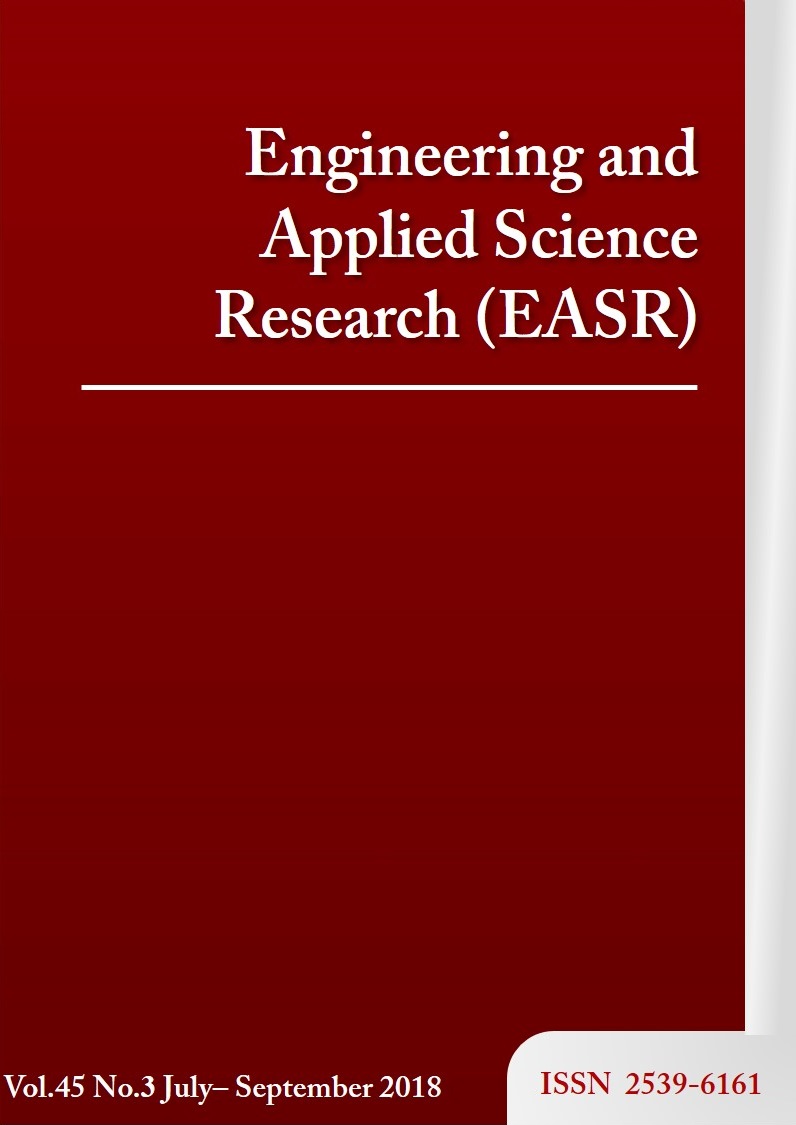Ozonation as cyanophyta control method for water treatment
Main Article Content
Abstract
A problem with the use of chemical oxidants for algae control in water treatment processes is an incomplete destruction of algal cells, leading to the clogging of the filter media. Ozone, with its high oxidizing power, can be used not only for treating many types of organic contaminants but also for destroying microorganisms. This study investigated the effect of ozone in controlling an algal population. The sample for the study, obtained from a raw water reservoir of the MWA Bangkhen Water Treatment plant (Thailand), was cultured in Bold’s Basal medium and used as a study population. Morphological identification of algae in raw water sample and cultured sample (study population) revealed that the predominant organisms were Chlorophyta, Cyanophyta and Bacillariophyta. Identification by PCR-DGGE and DNA sequencing of Cyanophyta in raw water and in the study population showed that the predominant algae were Oscillatoria sp. (99% similarity), Limnothrix sp. (99% similarity) and Merismopedia sp. (93% similarity). Ozonation was conducted using ozone gas from a corona discharge type generator, generated at the rate of 3.7 mg/min. The results showed that ozone successfully destroyed algae. With 15.4 mg O3/L, the initial population of 1,021 μg chlorophyll-a/L was reduced by 72.4%. This was equivalent to the removal rate of 47μg chlorophyll-a/mg O3. The re-culturing of the ozonated algae population, both in supernatant and sludge, yielded no change in chlorophyll-a content. Also no presence of a cyanophyta DNA fingerprint was observed on agarose gel. This indicated that regrowth did not occur and ozonation completely destroyed all the algae.
Article Details
This work is licensed under a Creative Commons Attribution-NonCommercial-NoDerivatives 4.0 International License.
References
Mackay D, Eutrophication of freshwaters, principles, problems and restoration. David Harper, Chapman and Hall, London, 1992.
Oliver R. L, Ganf G.G. Freshwater blooms. In : Whitton, B. A, Potts M, editors. The ecology of cyanobacteria – Their diversity in time and space. Springer Netherland ; 2000. p. 149–194.
Ozawa K, Fukioka M, Muranaka M, Yokoyama A, Katagami Y, Homma T, Ishikawa K, Tsujimura S, Kumagai M, Watanabe M.F, Park H.D. Spatial distribution and temporal variation of Microcystis species composition and Microcystin concentration in Lake Biwa. Environmental Technology 2005; 20 (No.3): 270-276.
Mahakhant A, Sano T, Ratanachot P, Tong-a-ram T, Srivastava V, Watanabe M, Kaya K. Detection of microcystins from cyanobacterial water blooms in Thailand fresh water. Phycological research 1998; 46 (s2): 25–29.
Wang X, Parkpian P, Fujimoto N, Ruchirawat K.M, Delaune R.D, Jugsujinda A. Environmental conditions associating microcystin production to Microcystis aeruginosa in a reservoir of Thailand. J of Environmental Science & Health Part A 2002; 37(7): 1181-1207.
Chaichana R, Arunlertareel C, Sricharoendham B, Veeravaitaya N. Quantity and distribution of plant nutrients on eutrophication in Bang Pra Reservoir, Chonburi Province. Kasetsart Journal. (Nat. Sci.) 2003; 37: 90-100.
Boondao S, Laoongpan N. Investigation of eutrophication in Bang Phra Reservoir, Chonburi Province. A report to the working group on Pest, Scientific Research and Development section, Research and Development Office, Department of Irrigation; 2007.
Suwanvitaya P, Suwan S. Predominant algae in Bang Phra reservoir : morphological and molecular identification. Proceeding of the 9th International Symposium on Lowland Technology; 2014 Sep 29-Oct 1; Saga university, Japan, p.646-651.
Khauntrairong T, Traichaiyaporn S. Diversity and seasonal succession of the phytoplankton community in Doi Tao lake, Chiang Mai province, northern Thailand. The natural history J of Chulalongkorn Univ 2008; 8(2): 143-156.
Araoz R, Molgo J, Tandeau de Marsac N. Neurotoxic cyanobacterial toxins. Toxicon 2010; Oct; 56(5):813-828.
Rinta-Kanto J.M, Wihelm S.W. Diversity of microcystin-producing cyanobacteria in spatially isolated regions of Lake Erie. Appl Environ Microbiol 2006; Jul; 72(7):5083-5085.
Park H.D, Iwami C, Watanabe M.F, Harada K, Okino T, Hayashi H. Temporal variabilities of the concentration of inter- and extracellular Microcystin and toxic Microcystis species in a hypertrophic lake, lake Suwa, Japan (1991-1994). Environmental Toxicology and Water Quality 1998; 13: 61-72.
Plummer J.D. Control of algae in drinking waters by coagulation and oxidation. [Doctoral Dissertations]. University of Massachusetts Amherst; 1999.
Suwanvitaya P, Chamnansilp W. Effect of oxidants on algal control by alum coagulation. Proceeding of the International Conference on the Preservation and Rehabilitation of Urban Water Environment for Asian Core Program; 2013 Nov 23; p146-150.
Huang W.J, Cheng B.L, Hu, S.K, Chu, C.H. Ozonation of algae and odor causing substances in eutrophic waters. J of Environmental Science & Health Part A 2006; 41 (8): 1587–1605.
Brooke S, Newcombe G, Nicholson B, Gunter K. Decrease in toxicity of microcystins LA and LR in drinking water by ozonation. Toxicon 2006; 48 (No.8): 1054–1059.
Rinta-Kanto J.M, Ouellette A.J.A, Boye, G.L, Twiss M.R, Bridgeman T.N, Wilhelm S.W. Quantification of toxic Microcystis spp. During the 2003 and 2004 blooms in western Lake Erie using quantitative real-time PCR. Environmental Science and Technology 2005; 39(No.11): 4198-4205.
Nubel U, Garcia-Pichel F, Muyzer G. PCR primers to amplify 16S rRNA genes from cyanobacteria. Applied and Environmental Microbiology. 1997; 63: 3327–3332.
Mahakhant, A., Chalermsiri, W., Kunyalung, W., Tungtananuwat, M. and Arunpairojana, V., Survey and collection of freshwater microalgae strain in Bangkok and Vicinity. Microbiological Resources Centre (MIRCEN), Thailand, Institute of Scientific and Technological Research (TISTR), 2001.
Wongrat L, Wongrat P, Ruangsomboon S. Diversity of Freshwater Phytoplankton in Thailand (Chlorophyta and Chromophyta). Department of Fishery Biology, Faculty of Fisheries, Kasetsart University, 2001.



